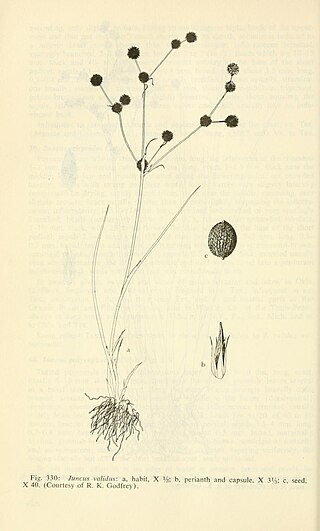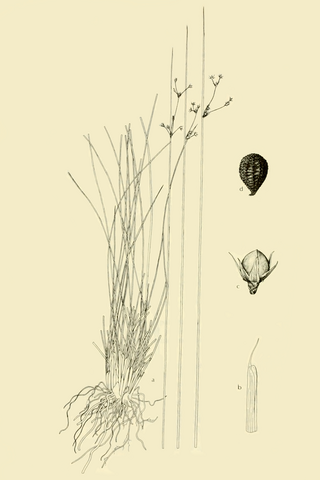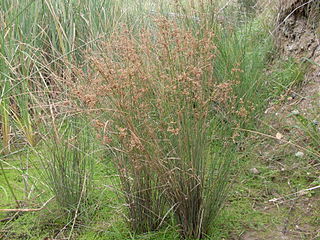
Juncaceae is a family of flowering plants, commonly known as the rush family. It consists of 8 genera and about 464 known species of slow-growing, rhizomatous, herbaceous monocotyledonous plants that may superficially resemble grasses and sedges. They often grow on infertile soils in a wide range of moisture conditions. The best-known and largest genus is Juncus. Most of the Juncus species grow exclusively in wetland habitats. A few rushes, such as Juncus bufonius are annuals, but most are perennials.

Juncus is a genus of monocotyledonous flowering plants, commonly known as rushes. It is the largest genus in the family Juncaceae, containing around 300 species.

Juncus effususis a perennial herbaceous flowering plant species in the rush family Juncaceae, with the common names common rush or soft rush. In North America, the common name soft rush also refers to Juncus interior.

Juncus bufonius, known commonly as toad rush, is a widespread flowering plant species complex in the rush family Juncaceae.

Juncus acutus, the spiny rush, sharp rush or sharp-pointed rush, is a flowering plant in the monocot family Juncaceae. It is native to the Americas, Northern and Southern Africa, Western and Southern Europe and West Asia, and is found in a variety of wet habitats, such as bogs, fens, meadows, and salt marshes, and along the edges of ponds and lakes.

Juncus articulatus is a flowering plant species in the rush family Juncaceae. It is known by the common name jointleaf rush or jointed rush, which can also refer to J. kraussii from Australia. It is native to Eurasia, Canada, Greenland, and much of the United States. It grows in moist areas, such as wet sand, and thrives in calcareous soils. J. articulatus was found to be more sensitive to drought and salt stress than its congeners J. acutus and J. maritimus. It is a perennial herb producing mainly erect stems from a short rhizome. The stem may root at nodes, and it generally has one or more flattened hollow cylindrical leaves up to 10 centimeters long. Transverse internal partitions or joints may be seen or felt in the leaf of the plant.

In botany and ecology, graminoid refers to a herbaceous plant with a grass-like morphology, i.e. elongated culms with long, blade-like leaves. They are contrasted to forbs, herbaceous plants without grass-like features.

Juncus kraussii commonly known as salt marsh rush, sea rush, jointed rush, matting rush or dune slack rush, is of the monocot family Juncaceae and genus Juncus. It grows in salt marshes, estuarine and coastal areas.

Juncus acutiflorus, also called sharp-flowered rush, is a rush or a grassy plant of the genus Juncus. As the name suggests, the plant has notable sharp-looking flowers, flowering between July and September.

Juncus pallidus, commonly known as the great soft-rushpale rush, giant rush, or leafless rush is a species of rush that is native to southern Australia, New Zealand, Norfolk Island, and Lord Howe Island. It is a vigorous, tufted, tussock-forming, rhizomatous perennial herb with culms growing to 70–135 cm in height. The inflorescence, which is 25–185 mm long, contains many straw coloured flowers, each with six floral segments. It is usually found in moist, nutrient-poor soils subject to periodic flooding, such as fresh and brackish waterways, including swamps, creek banks, lake edges and sand seeps.

Juncus planifolius is a species of rush, commonly known as broadleaf rush, broad-leaved rush, or grass-leaved rush. It naturally occurs in Australia, New Zealand, Hawaii and South America.

Juncus dichotomus is a monocot in the Juncaceae family of rushes. The plant is native to the Americas in temperate zones but has been introduced to other parts of the world. Juncus dichotomus often is found in very moist areas and where rainfall is a common occurrence. It is often most recognizable in the spring and summer months due to its conspicuous flowers and infructescence.

Juncus antarcticus, also known as dwarf rush, is a flowering plant species in the rush family Juncaceae, native to New Zealand and Australia.

Juncus scirpoides, the needlepod rush, is a species of flowering plant in the family Juncaceae, native to the central and eastern United States. It prefers wet sandy soils, and among the many places it grows it is common in the enigmatic Carolina bays.

Juncus validus, the roundhead rush, is a species of flowering plant in the family Juncaceae, native to the central and southeastern United States. It is a somewhat weedy species, found along wet roadsides and in ditches.

Juncus coriaceus, the leathery rush, is a species of flowering plant in the family Juncaceae, native to the southeastern United States, from Texas to Cape May, New Jersey. A report from New York state turns out to have been erroneous. A wetland species, it prefers poorly drained soils.

Juncus usitatus, the common rush, is a species of flowering plant in the rush family, Juncaceae. A graceful, clumping plant growing from 40 cm to 1.1 metres high. Commonly found in New Zealand and eastern Australia in disturbed sites by stream banks and other moist habitats. The specific epithet is derived from Latin, meaning "common or usual".

Juncus homalocaulis is a species of flowering plant in the rush family, Juncaceae. A tufted, perennial plant growing from 5 cm to 35 cm tall, with stems 0.5 to 1.2 mm thick. Often found in Australia and New Zealand in moist grassland or woodland. The specific epithet is derived from Greek, meaning "even stem".

Juncus hybridus is a species of annual herb in the family Juncaceae (rushes). They have a self-supporting growth form and have simple, broad leaves.
Juncus capillaceus is a rush species native to South America, but has been introduced to other parts of the world.


















